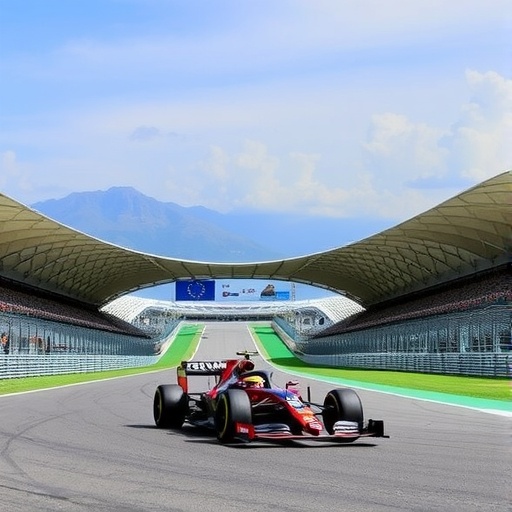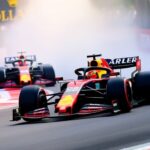Formula 1 Mexico City Grand Prix Practice Sessions Kick Off at Autodromo Hermanos Rodríguez Amid High Stakes
In the shadow of the iconic Autodromo Hermanos Rodríguez, the roar of Formula 1 engines echoed through Mexico City’s high-altitude air today as teams launched into the crucial practice sessions for the upcoming Mexico City Grand Prix. With Sunday’s main event looming, drivers like Max Verstappen and Lewis Hamilton wasted no time fine-tuning their machines on the demanding 4.304-kilometer circuit, setting the stage for what promises to be a thrilling chapter in the 2023 season.
- Autodromo Hermanos Rodríguez Awakens with High-Octane Practice Laps
- Top Drivers Battle for Supremacy in FP2 Amid Setup Tweaks
- Altitude and Weather Add Unpredictable Twists to Practice Strategies
- Team Principals Share Insights on Championship Implications
- Qualifying Looms as Teams Eye Glory on Sunday Horizon
The Mexico City Grand Prix, a staple on the Formula 1 calendar since its return in 2015, draws massive crowds to the historic track named after the Rodriguez brothers—Ricardo and Pedro—legendary Mexican racers. This year’s practice sessions mark the beginning of a weekend packed with intensity, where every lap could shift the championship dynamics. As teams navigate the unique challenges of the venue’s elevation of over 2,200 meters, which affects engine performance and tire wear, the focus is squarely on data collection and setup optimization.
Early reports from the paddock indicate that Red Bull Racing’s Verstappen clocked an impressive lap time in the first session, underscoring his dominance this season. Meanwhile, Mercedes and Ferrari are pushing hard to close the gap, with engineers poring over telemetry to combat the thin air’s impact on aerodynamics. The practice runs, divided into FP1, FP2, and FP3, provide invaluable insights before qualifying on Saturday, making today’s action a must-watch for fans worldwide.
Autodromo Hermanos Rodríguez Awakens with High-Octane Practice Laps
The Autodromo Hermanos Rodríguez burst back to life as Formula 1 practice sessions commenced under clear skies, but with the ever-present threat of afternoon thunderstorms typical to Mexico City’s October weather. The circuit, blending modern facilities with nods to its 1960s origins, features the famous stadium section where the passionate Tifosi and local fans create an electric atmosphere even during these preparatory runs.
In FP1, which kicked off at 1:30 p.m. local time, McLaren’s Lando Norris surprised onlookers by topping the timesheets with a 1:18.128 lap, edging out Verstappen by a mere 0.045 seconds. This early benchmark highlighted the competitive field, as teams experimented with soft compound tires to gather maximum data. The session saw minimal interruptions, allowing for 25 laps per driver on average, a statistic that bodes well for the weekend’s productivity.
Technical director for Alpine, Pat Fry, commented post-session, “The altitude here is a beast—engines lose around 20% power compared to sea level, so we’re recalibrating fuel mixtures and cooling systems aggressively.” Such adjustments are critical in Formula 1 racing, where milliseconds matter. The track’s layout, with its long straights leading into tight esses, demands precise handling, and today’s practices revealed teams like Haas focusing on understeer issues in the esses.
Historical context adds depth to these sessions: The circuit has hosted 22 Grands Prix since 1963, with only two editions canceled due to crowd violence in the 1970s. Recent winners include Sergio Pérez in 2021, a home hero who thrilled the 120,000-strong crowd. As practice unfolded, local fans chanted for Checo, whose Red Bull teammate Verstappen seeks to extend his championship lead to 100 points over Pérez.
Beyond the laps, sustainability efforts shone through. Formula 1’s push towards net-zero carbon by 2030 was evident, with teams using biofuels in engines and recycling initiatives in the paddock. The Autodromo’s solar-powered grandstands further underscore the sport’s green evolution, even as the raw power of 1,000-horsepower hybrids thunders around the loop.
Top Drivers Battle for Supremacy in FP2 Amid Setup Tweaks
As the sun dipped lower, FP2 intensified the Mexico City Grand Prix preparations, with Ferrari’s Charles Leclerc posting a blistering 1:17.945 to lead the pack. This session, starting at 5:00 p.m., allowed teams to test medium and hard tires under evolving track conditions, where temperatures dropped from 28°C to 20°C, affecting grip levels significantly.
Verstappen, undeterred, responded with consistent long runs, simulating race pace and clocking over 30 laps without issue. His RB19 car, honed after a dominant Singapore, appeared unfazed by the altitude penalty, which historically favors teams with efficient energy recovery systems. Mercedes’ George Russell encountered a minor hydraulic glitch, limiting his time to 18 laps, but team principal Toto Wolff remained optimistic: “It’s a small hiccup; the data from the first hour is gold for tomorrow.”
Statistics from the session paint a vivid picture: Average lap speeds hovered around 210 km/h, with the top 10 separated by just 0.8 seconds—a razor-thin margin in Formula 1. Pérez, drawing energy from the home crowd, focused on overtaking maneuvers at Turn 1, the circuit’s notorious hairpin. His practice stint included a bold move on teammate Verstappen during a traffic simulation, showcasing the intra-team dynamics at play.
Emerging talents also made waves. Williams’ Alex Albon, battling for midfield points, improved his personal best by 1.2 seconds from FP1, crediting new front wing adjustments. In the broader context of the season, with 20 races down and six to go, these practice sessions are pivotal. The drivers’ championship sees Verstappen at 285 points, followed by Pérez at 185, while constructors’ honors have Red Bull on 470, Ferrari trailing at 312.
Fan engagement amplified the buzz. Over 50,000 spectators filled the stands during FP2, waving Mexican flags and chanting in unison. Social media exploded with #MexicoGP trending globally, as clips of near-misses in the esses garnered millions of views. This grassroots passion fuels Formula 1’s growth in Latin America, where viewership has surged 30% year-over-year.
Altitude and Weather Add Unpredictable Twists to Practice Strategies
The unique environmental factors at Autodromo Hermanos Rodríguez turned today’s practice sessions into a masterclass in adaptation for Formula 1 teams. At 2,285 meters above sea level, the thinner air reduces downforce by up to 10%, forcing aerodynamic tweaks that could define qualifying outcomes.
During FP1, a brief rain shower at the 45-minute mark prompted a flurry of intermediate tire changes, with Aston Martin’s Fernando Alonso quickest on wets at 1:20.456. This previewed potential chaos for Sunday’s race, where forecasts predict 40% chance of showers. Teams like Sauber utilized the wet conditions to test drainage setups, vital given the circuit’s history of aquaplaning in the final sector.
Engineers highlighted the power unit strains: Turbochargers work overtime to compensate for oxygen scarcity, increasing wear by 15% per session. Renault’s power unit, supplying several teams, reported no major failures, but monitoring remains intense. Quote from FIA technical delegate: “Safety protocols are heightened; we’re ensuring all cars meet the 110% rule under these conditions.”
Comparing to past Mexico City Grand Prix events, 2022’s dry weekend allowed for record laps, but 2019’s rain-soaked race saw six retirements, including Hamilton’s early exit. Today’s practices echoed that variability, with AlphaTauri’s Yuki Tsunoda spinning at Turn 12 due to overzealous braking. Recovery was swift, thanks to the track’s wide run-off areas upgraded in 2015.
Beyond tech, health considerations for drivers are paramount. The altitude causes quicker fatigue, with heart rates spiking 20% higher than at Monza. Hydration stations dotted the pit lane, and medical teams conducted pre-session checks. Pérez, acclimated as a local, joked in a presser, “For me, it’s home advantage—others are gasping while I’m just racing.”
Strategic depth emerged in tire management. Pirelli, supplying the weekend, allocated three compounds: C3 (hard), C4 (medium), and C5 (soft), with the latter degrading fastest due to heat buildup. Teams ran simulations for two-stop strategies, projecting 58 laps on Sunday with pit windows between laps 15-20 and 35-40.
Team Principals Share Insights on Championship Implications
Post-practice debriefs revealed the strategic undercurrents shaping the Mexico City Grand Prix. Red Bull’s Christian Horner emphasized long-term gains: “These sessions are about survival here; get it right, and Sunday’s podium is yours.” With Verstappen chasing a fourth consecutive title, every setup tweak counts.
Ferrari’s Fred Vasseur discussed upgrades: “Our floor revision shows promise in the high-speed sections—vital for overtaking on this track.” The Italian squad, aiming to rebound from Austin woes, invested heavily in simulation data pre-arrival. Mercedes, meanwhile, focused on balance, with Hamilton noting, “The car feels alive; altitude evens the field a bit.”
Midfield battles heated up too. McLaren’s Andrea Stella praised Norris’s consistency, positioning them for potential points hauls. In constructors’, the fight for P4 sees McLaren at 220 points, just ahead of Aston Martin at 215. Quotes from the FIA race director underscored fairness: “All teams complied with parc fermé rules from the get-go.”
Looking at broader impacts, the event boosts Mexico’s economy by $200 million annually, per local reports, with 400,000 visitors expected. Sponsorships, from local beer giants to global tech firms, thrive on the spectacle. Women’s initiatives, like the F1 Academy showcase, added inclusivity, with young drivers observing practices.
Incidents were few: A minor clash between Albon and Gasly at Turn 4 resulted in no penalties, but served as a reminder of the track’s unforgiving nature. Virtual Safety Car deployments in practice honed response times, preparing for race-day unpredictability.
Qualifying Looms as Teams Eye Glory on Sunday Horizon
With FP3 set for Saturday morning, the Mexico City Grand Prix weekend accelerates toward its climax. Qualifying at 4:00 p.m. will determine the grid, where pole position has historically led to victory in 70% of recent races here. Teams are already plotting aggressive pushes, with simulations predicting Verstappen as favorite at 1:16.800 pace.
Forward momentum builds excitement: Pérez dreams of a home win, potentially his third in Mexico, while challengers like Leclerc target Red Bull’s heel. The race, starting at 3:00 p.m. Sunday, spans 71 laps and could see strategy shake-ups if rain intervenes. Championship ramifications are huge— a Verstappen win extends his lead to insurmountable levels, pressuring rivals to respond.
Fans can expect enhanced broadcasts, with onboard cams capturing the stadium roar. Off-track, concerts by artists like Bad Bunny heighten the fiesta vibe. As engines cool tonight, anticipation simmers; the Autodromo Hermanos Rodríguez is primed for another legendary Formula 1 showdown, where heroes rise and underdogs shine under the Mexican sun.










